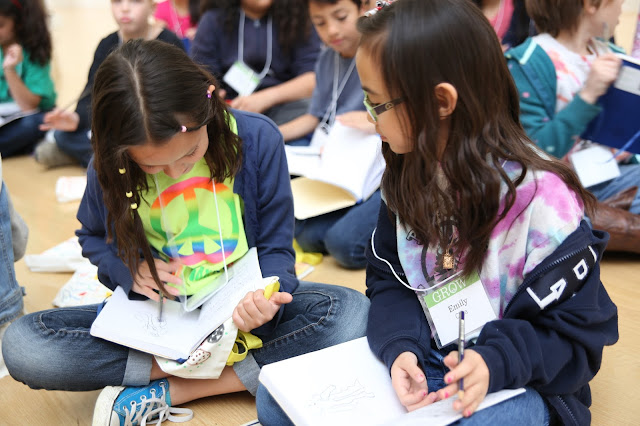Visit 3 Vocabulary:
figure / figura
bust / busto
portrait /
retrato
realistic /
realista
abstract /
abstracto
profile / perfil
We began by comparing and contrasting sculptures by Willem de Kooning and Alberto Giacometti. How many similarities and differences can you find?
 |
| Willem de Kooning, Clamdigger, 1972 |
 |
| Alberto Giacometti; Bust of Diego, 1954 (left), Diego in a Sweater, 1953 (middle), Diego in a Cloak, 1954 (right) |
The students divided into pairs, and each person was given a challenge. During the 2nd grade tour, each partner was assigned to Clamdigger by Willem de Kooning or Diego in a Sweater by Alberto Giacometti. Students were asked to write down descriptive words about their specific sculpture. Then, the pairs compared their lists and noted which words both partners had written down about their sculptures. Finally, they decided together whether the artworks appeared to have more differences or more in common.
2nd grade
In the 3rd and 4th grade tours, one partner was challenged to write down similarities between the sculptures, while the other partner wrote down differences between the sculptures. Then, students were given the task of convincing their partners that the sculptures were more similar or more different, based on the lists that they made. This resulted in some lively and animated conversations.
3rd grade
4th grade
We introduced most of our vocabulary words while discussing these sculptures. As mentioned earlier, the figure refers to the human form in a work of art. While the Clamdigger shows the whole figure, Bust of Diego and Diego in a Cloak are referred to as busts because they only show the head and shoulders. In addition, the three sculptures by Alberto Giacometti (Bust of Diego, Diego in a Sweater, and Diego in a Cloak) all represent a real person - the artist's brother Diego - so they are considered portraits.
We also discussed what it means for a work of art to look realistic or abstract. Students felt the sculptures by Alberto Giacometti are more realistic, since the heads, bodies, and facial features are more defined (although the heads on Diego in a Sweater and Diego in a Cloak seem a little too small!). Clamdigger was considered more abstract by the students because the facial features and body are roughly formed, have less detail, and look less like an actual person.
The following questions inspired some fun, thoughtful conversations:
- Why would an artist choose to sculpt a person like this?
- If an artist were to make a sculpture of you, would you want it to look like Clamdigger or like Giacometti's sculptures of his brother Diego? Why?
It might be fun to have this conversation at home with parents, grandparents, brothers, sisters, or other friends and relatives!
Stay tuned for more blog posts about our tour. And, SAVE THE DATE for Rosemont Family Day at the Nasher Sculpture Center from 12:00-2:00 p.m. on Saturday, May 14! We look forward to seeing everyone and their families.


























